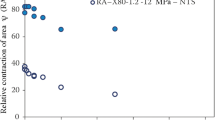Abstract
Hydrogen usually penetrates metals through defects such as dislocations, vacancies, and crystalline imperfections and causes embrittlement, leading to cleavage fracture and intergranular fracture. Synthetic natural gas produced by coal gasification, biogas, and landfill gas inevitably contain hydrogen. Therefore, hydrogen embrittlement of pipeline materials should be considered when they are mixed with conventional natural gas and supplied to customers. To analyze hydrogen embrittlement of base metals and girth weld metals of API 5L X70 and X65 gas pipelines, a specimen was treated in 100 % hydrogen environment at 10 MPa to determine the hydrogen concentration in it. Small punch (SP) tests were performed under various gaseous components and pressures. When SP tests were performed at very low speed, hydrogen embrittlement could be observed. Specimens became very susceptible to hydrogen embrittlement with increasing hydrogen partial pressure in the hydrogen/methane gas mixture, and the SP energy also decreased dramatically.
Similar content being viewed by others
References
W. S. Kim, C. M. Kim and S. H. Nam, A study on the maximum allowable hydrogen content of injected SNG in high pressure natural gas pipeline, World Gas Conference Paris 2016 (2015).
D. Balch, C. San Marchi and B. Somerday, Hydrogenassisted fracture: Materials testing and variables governing fracture, Sandia national laboratories, Hydrogen Pipeline Working Group Workshop (2005).
C. San Marchi and B. Somerday, Technical reference on hydrogen compatibility of materials, Sandia National Laboratories (2008).
H. Barthelemy and G. Pressouyre, Hydrogen gas embrittlement of steels: Synthesis of a subtask of the CEC hydrogen energy programme (1975-83), Commission of the European Communities (1985).
CEN Workshop Agreement, CWA 15627, Small punch test method for metallic materials (2007).
C. M. Kim, W. S. Kim and Y. T. Kho, The effects of hydrogen embrittlement by cathodic protection on the CTOD of buried naturals gas pipeline, Metals and Materials International, 8 (2002) 197–202.
N. Hagiwara and N. Oguchi, Fracture toughness (CTOD) of line pipe materials under cathodic protection,’ 97 Osaka Gas Forum, paper No 200.
J. Toribio, D. Vergara and M. Lorenzo, Influence of loading rate on hydrogen-assisted micro-damage in bluntly notched samples of pearlitic steel, Metals, 6 (2016) 11.
J. Toribio, The role of crack tip strain rate in hydrogen assisted cracking, Corrosion Science, 399 (1997) 1687–1697.
ASTM G142, Standard test method for determination of susceptibility of metals to embrittlement in hydrogen containing environments at high pressure, high temperature, or both, ASTM International (2011).
Author information
Authors and Affiliations
Corresponding author
Additional information
Cheol-Man Kim is Senior Research Engineer in Korea Gas Corporation, Korea. He received his M.S. degree in Metallurgical Engineering from Kookmin University in 1996, Korea. His major interests are material evaluation, welding and NDT, damage analysis, defect assessment and repair of pipeline, and fracture mechanics.
Young-Pyo Kim is a Chief Research Engineer of Gas Facility Technology Center in KOGAS Research Institute, Korea. He received a Ph.D. degree in Material Science and Engineering from Seoul National University in 2008. He joined KOGAS in 1992. His research fields are welding, failure analysis, integrity assessment and repair technology of onshore and offshore pipelines. Nowadays, he studies deep into structural and hydraulic design and engineering of the natural gas transmission pipeline in the arctic area and offshore.
Woo-Sik Kim is a Chief Research Engineer in KOGAS Research Institute, Korea. He received his Ph.D. degree in Metallurgical Engineering from Seoul National University in 1993. His major interests are design, construction, integrity assessment and remaining life prediction of buried pipeline.
Rights and permissions
About this article
Cite this article
Kim, C.M., Kim, Y.P. & Kim, W.S. Influence of gaseous components and pressures on hydrogen embrittlement of natural gas pipeline. J Mech Sci Technol 31, 3691–3695 (2017). https://doi.org/10.1007/s12206-017-0711-2
Received:
Revised:
Accepted:
Published:
Issue Date:
DOI: https://doi.org/10.1007/s12206-017-0711-2




